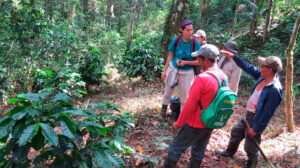Agroforests: Where Culture, Commerce, and Conservation Collide
What happens when farmers, forests, and global markets all meet on the same patch of land? My research explores this very question by diving into the rich and complex world of agroforestry systems—especially those that grow one of the world’s favorite crop: coffee.
Agroforestry is more than a farming practice. It’s a living landscape where biodiversity, local traditions, market forces and a changing climate are constantly shaping one another. In my work, I investigate how farmers’ decisions—guided by traditional knowledge, economic pressures, and ecological understanding—affect the biodiversity and ecological functioning of these systems.
What we’ve found is both fascinating and sobering. While agroforestry can support biodiversity, the way it’s managed matters—a lot. Traditional knowledge and practices help maintain ecological richness, but shifts in commodity prices or demands from niche markets like organic or fair-trade coffee can drive changes in how land is managed. These shifts can move agroforests away from their original biodiversity and ecological balance.
Through international collaborations and graduate students’ research, we’ve helped show that when managed thoughtfully, agroforestry can do much more than grow crops—it can restore critical ecosystem services, support nutrient cycling, and protect habitats that are under threat. All these while allowing farmers to be less dependent on external inputs (e.g., fertilizers and pesticides) by relying more on the pest suppression and soil nutrient cycling ecosystem services of their landscapes.
However, our latest work, funded by the National Geographic Society, is showing that disruptions like coffee leaf rust—a fungal disease—and climate change are threatening the stability of coffee agroforestry systems and the farmers who depend on these landscapes.
This work reminds us that farms are not just places of production. They are socioecological systems where people, biocultural heritage and nature converge. Understanding how people and nature interact within them is key to designing farming futures that are both sustainable and just.

If you want to read more…
Auliz-Ortiz, D. M., Benítez-Malvido, J., Arroyo-Rodríguez, V., Dirzo, R., Pérez-Farrera, M. Á., Luna-Reyes, R., Mendoza, E., Álvarez-Añorve, M. Y., Álvarez-Sánchez, J., Arias-Ataide, D. M., Ávila-Cabadilla, L. D., Botello, F., Braasch, M., Casas, A., Campos-Villanueva, D. Á., Cedeño-Vázquez, J. R., Chávez-Tovar, J. C., Coates, R., Dechnik-Vázquez, Y., …, Valencia, V…. Martínez-Ramos, M. (2024). Underlying and proximate drivers of biodiversity changes in Mesoamerican biosphere reserves. Proceedings of the National Academy of Sciences, 121(6), e2305944121.
https://doi.org/10.1073/pnas.2305944121
Barrios, E., Valencia, V., Jonsson, M., Brauman, A., Hairiah, K., Mortimer, P. E., Okubo, S., & Albert, C. (2018). Contribution of trees to the conservation of biodiversity and ecosystem services in agricultural landscapes. International Journal of Biodiversity Science, Ecosystem Services & Management, 14(1), 1–16. https://doi.org/10.1080/21513732.2017.1399167
García-Barrios, L., Cruz-Morales, J., Braasch, M., Dechnik-Vázquez, Y., Gutiérrez-Navarro, A., Meza-Jiménez, A., Rivera-Núñez, T., Speelman, E., Trujillo-Díaz, G., Valencia, V., & Zabala, A. (2020). Challenges for Rural Livelihoods, Participatory Agroforestry, and Biodiversity Conservation in a Neotropical Biosphere Reserve in Mexico. In L. García-Barrios (Ed.), Participatory Biodiversity Conservation (pp. 69–89). Springer International Publishing.
https://doi.org/10.1007/978-3-030-41686-7_5
Harvey, C. A., Pritts, A. A., Zwetsloot, M. J., Jansen, K., Pulleman, M. M., Armbrecht, I., Avelino, J., Barrera, J. F., Bunn, C., García, J. H., Isaza, C., Munoz-Ucros, J., Pérez-Alemán, C. J., Rahn, E., Robiglio, V., Somarriba, E., & Valencia, V*. (2021). Transformation of coffee-growing landscapes across Latin America. A review. Agronomy for Sustainable Development, 41(5), 62.
https://doi.org/10.1007/s13593-021-00712-0
Silva-Galicia, A.**, Valencia, V., Arroyo-Rodríguez, V., & Ceccon, E. (2023). Weight-of-evidence approach for assessing agroforestry contributions to restore key ecosystem services in tropical dry forests. Agroforestry Systems, 97(2), 151–161.
https://doi.org/10.1007/s10457-022-00794-z
Steinfeld, J. P**., Miatton, M., Creamer, R. E., Ehbrecht, M., Valencia, V., Ballester, M. V. R., & Bianchi, F. J. J. A. (2024). Identifying agroforestry characteristics for enhanced nutrient cycling potential in Brazil. Agriculture, Ecosystems & Environment, 362, 108828.
https://doi.org/10.1016/j.agee.2023.108828
Valencia, V.*, García-Barrios, L., Sterling, E. J., West, P., Meza-Jiménez, A., & Naeem, S. (2018). Smallholder response to environmental change: Impacts of coffee leaf rust in a forest frontier in Mexico. Land Use Policy, 79, 463–474.
https://doi.org/10.1016/j.landusepol.2018.08.020
Valencia, V.*, García-Barrios, L., West, P., Sterling, E. J., & Naeem, S. (2014). The role of coffee agroforestry in the conservation of tree diversity and community composition of native forests in a Biosphere Reserve. Agriculture, Ecosystems & Environment, 189, 154–163.
https://doi.org/10.1016/j.agee.2014.03.024
Valencia, V.*, Naeem, S., García-Barrios, L., West, P., & Sterling, E. J. (2016). Conservation of tree species of late succession and conservation concern in coffee agroforestry systems. Agriculture, Ecosystems & Environment, 219, 32–41.
https://doi.org/10.1016/j.agee.2015.12.004
Valencia, V.*, West, P., Sterling, E. J., García-Barrios, L., & Naeem, S. (2015). The use of farmers’ knowledge in coffee agroforestry management: implications for the conservation of tree biodiversity. Ecosphere, 6(7), art122.
https://doi.org/10.1890/ES14-00428.1
*corresponding author
**Supervised student
